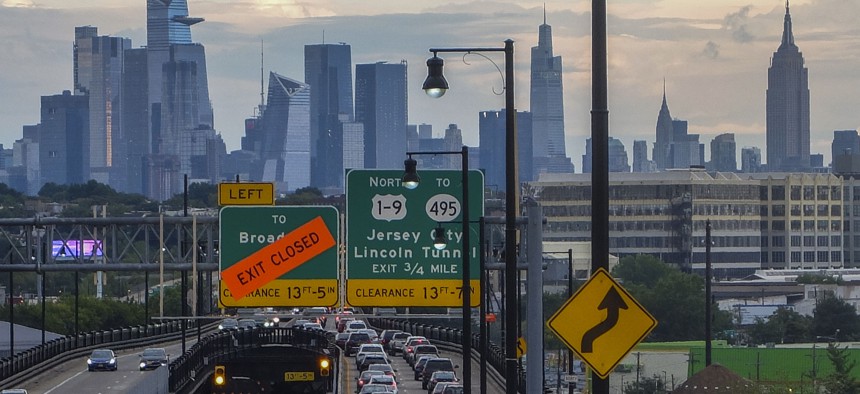Congestion Pricing in Manhattan Clears Federal Hurdle

Eduardo Munoz Alvarez/VIEWpress via Getty Images
The city still has to determine the details before New York becomes the first American city to charge for the right to drive on certain roads.
New York City received a long-sought approval from the federal government to begin tolling drivers who clog Manhattan streets, in a “congestion pricing” scheme that could generate $1 billion a year for its beleaguered subway system.
The U.S. Department of Transportation signed off on the environmental reviews for the plan late Friday, removing one of the biggest procedural hurdles for state and local officials to roll out the tolls by 2024.
The cordoned-off area would include all of Manhattan south of 60th Street. Tolls are expected to be between $9 and $23 per vehicle, but local officials have not yet decided the rate. They will also determine who should be exempt from paying the tolls.
If it goes into effect, New York would be the first U.S. city to use congestion pricing, although internationally, cities such as London, Singapore and Stockholm have used such tolling zones for years.
Nick Benson, a spokesperson for the New York City Department of Transportation, called the federal approval “a significant step forward.”
“Our shared vision for congestion pricing will reduce traffic, improve air quality and raise critical funding for our subways and buses,” Benson said in a statement.
Tiffany-Ann Taylor, vice president for transportation at the Regional Plan Association (RPA), said the effects on downtown streets should be quick to see once the tolling plan is put into place, even if it takes a few years for physical improvements to the subway system to take shape.
“You should see more folks using public transportation and bike share, walking and maybe even using their own bicycles,” she said. “You should also see faster travel times for folks who have to drive, or maybe faster travel times for emergency vehicles or even freight delivery.”
In other cities that have used congestion pricing, the amount of traffic immediately outside the tolled zone decreased as well, she said, because people opted to use different modes of transportation for their entire trip.
There are potential downsides, though, that Taylor said New York area officials should plan for, such as increased truck traffic in neighborhoods outside the cordoned zone as truckers avoid the new tolls. She said state and local officials could offset some of the increased pollution from heavy vehicles by rapidly replacing buses running on fossil fuels with electric-powered buses.
Elected officials and advocates have tossed around the idea of imposing tolls on Manhattan-bound drivers for decades. The traffic in the heart of the city is legendary, and geography—the fact that Manhattan is an island with only a few crossings in most directions—makes the logistics relatively straightforward.
But it’s been a tough sell politically. Former Mayor Michael Bloomberg first floated the idea in 2007, but it never got the necessary state approval in Albany. Suburban and outer borough lawmakers effectively killed the idea behind closed doors, amid concerns that it would disproportionately help rich residents of Manhattan.
A decade later, though, state leaders scrambled to find ways to shore up the finances of the Metropolitan Transportation Authority, which runs the city’s subways and buses. They settled on congestion pricing in 2019.
The plan needed federal approval, though, which became an issue because then-President Donald Trump had been feuding with New York area leaders on a host of issues and held up infrastructure improvements as part of the disputes. The Trump administration dragged its feet on the environmental review on congestion pricing, refusing to even tell MTA leaders what it needed for the approval process. The Biden administration, though, quickly reversed course and told New York leaders it would prioritize the review process.
Locally, the proposal has also irked several prominent politicians. New York Mayor Eric Adams, who assumed office after the state legislation passed, complained last year that the process was driven by Albany politicians. “New York City has very little input. I mean, New York state just wants to control New York City too often,” Adams said, calling for more exemptions of who would have to pay the tolls.
New Jersey Gov. Phil Murphy, a Democrat, called the federal approval Friday “unfair and ill-advised.” He also hinted he might sue to block the plan, saying he was “closely assessing all legal options.”
“Everyone in the region deserves more access to more reliable mass transit, but placing an unjustified financial burden on the backs of hardworking New Jersey commuters is wrong. Simply put, it’s a money grab,” Murphy said in a statement.
The governor listed many ways he thought New Jersey residents would bear the brunt of the plan, including “double tolling, toll shopping, a lack of revenue for NJ Transit, outsized environmental burdens on certain North Jersey communities, and financial impacts on the Port Authority’s budget.”
The Port Authority of New York and New Jersey operates several bridges, tunnels, a bus terminal and a rapid transit system that connect the two states, along with the region’s airports and the World Trade Center.
Taylor said the opposition from Murphy and other New Jersey officials has been “really frustrating to hear.”
“The fact of the matter is the folks who are commuting to New Jersey are mostly coming in through public transit… Also, once folks come into New York, many of them are then jumping on the MTA system directly,” she said. “Folks who live in New Jersey and other parts of the region actually are benefiting directly from the program.”
And for New Jersey residents who still need or want to drive into the city? “The idea with congestion pricing is that your drive should be easier,” Taylor said, “because you’re deterring more drivers from driving into the central business district.”
Daniel C. Vock is a senior reporter for Route Fifty based in Washington, D.C.
NEXT STORY: Local leaders feel cloud migration pressure, survey says






